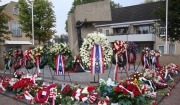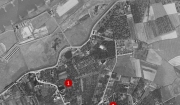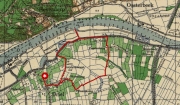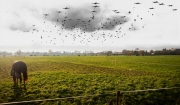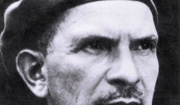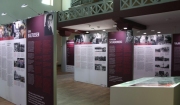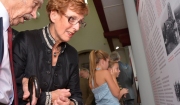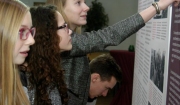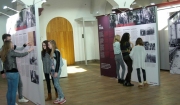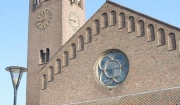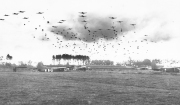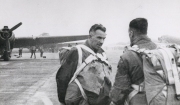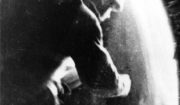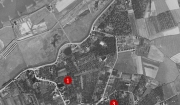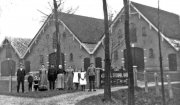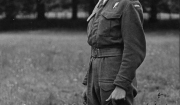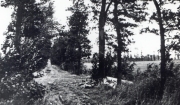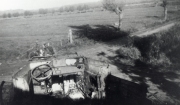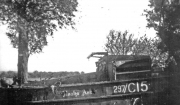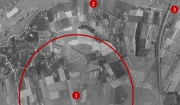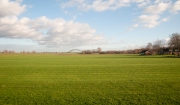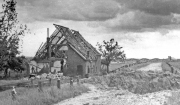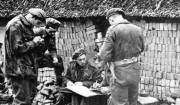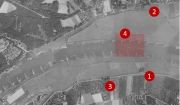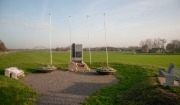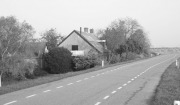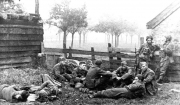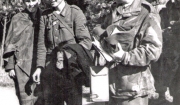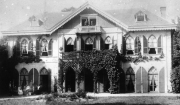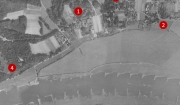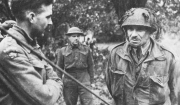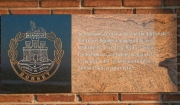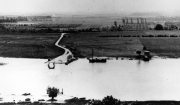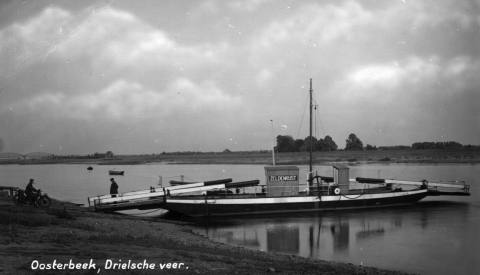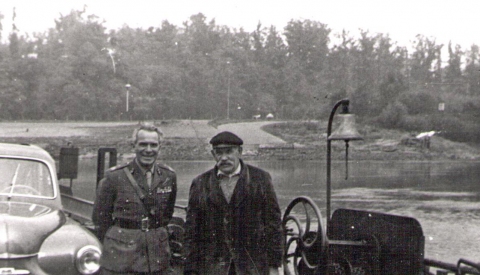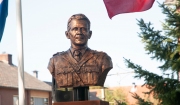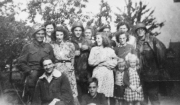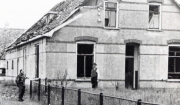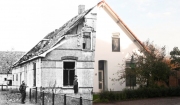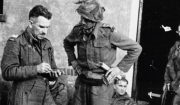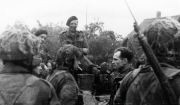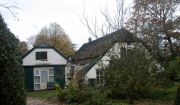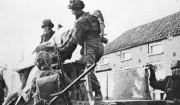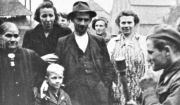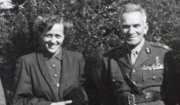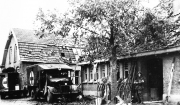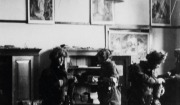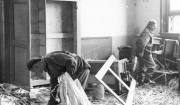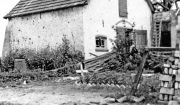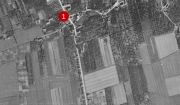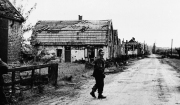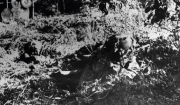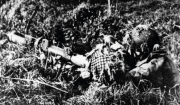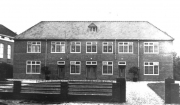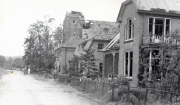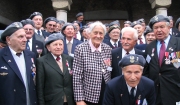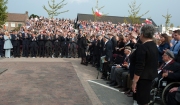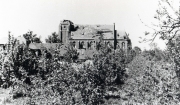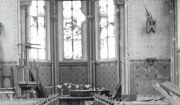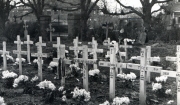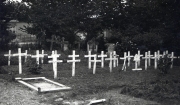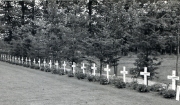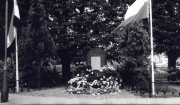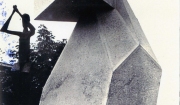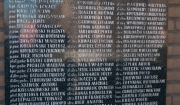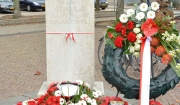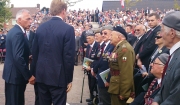The Driel Polen Foundation has put together a walking route of approximately 6 kilometers. It departs from the Information Center, takes you over the landing areas and back to Driel via the dike. By means of short texts and images, the route takes you back to 1944 and the deployment of the Poles during operation Market Garden.
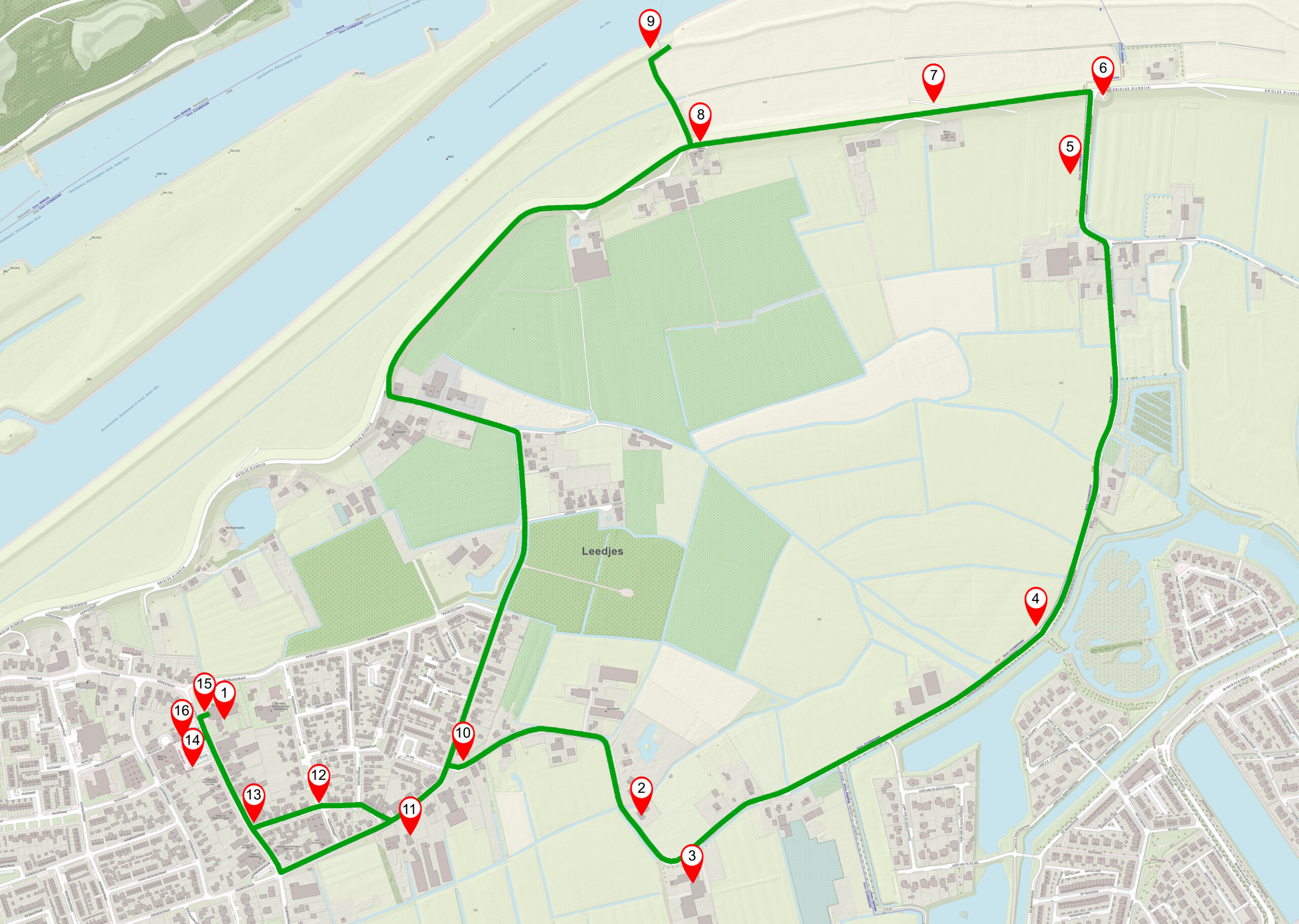
Download here the GPX file for navigation |
Download here a PDF version to print |
You depart from the information center where you can first learn more about the story of the brigade and their efforts. You will also read how Sosabowksi, as a critic of the British High Command, became the scapegoat after the failure of the operation and how the rehabilitation was achieved in 2006.
1. Information Center
On September 21st, 1944, the 1st Polish Independent Parachute Brigade landed during Operation Market Garden near the village of Driel. The consequences were great, both for the civilian population of Driel and for the Polish paratroopers.
The information center at the back of the Catholic Church sheds light on the struggle of the 1st Polish Independent Parachute Brigade near Driel during Operation Market Garden.
It also discusses the origin of this brigade, the dishonourable treatment of the Poles after the failure of operation Market Garden, the rehabilitation and the close bond that exists between Driel and Poland.
2. Landing sites – then fields and orchards
On September 21st 1944, around 17:15, this was the landing area of the Polish troops. Around 1000 paratroopers were dropped here.
On September 21st 1944, this area formed ‘Dropzone K’ (DZ K). The surroundings of Driel at that time mainly consisted out of fields and orchards. At 17:15, around 1000 paratroopers of the 1st Polish Independent Parachute Brigade jumped out of the 73 Dakota-transport planes of the American air force and landed on these fields.
3. The first clashes: German attacks repelled, losses to be mourned
The Polish troops took up positions in and around Driel, including at the predecessor of this post-war farm, the Baarskamp. 2nd Lieutenant Richard Tice was killed in a first German attack on one of the Polish positions.
During the first night, the Polish troops tried to reach Oosterbeek to support the surrounded British troops there. Unfortunately, they did not succeed in crossing the Rhine river, after which the Polish soldiers took positions near Driel in the early hours of September 22nd, 1944.
One of the Polish positions was located in the predecessor of the post-war farm Baarskamp. A platoon of 28 men under the command of 2nd Lieutenant Richard Tice created foxholes around the farm. A first German attack, supported by armoured vehicles, was repelled. During this attack, Tice got killed.
4. Stranded aid: supplies do not reach the British troops in Oosterbeek
In the evening of Friday September 22nd 1944, parts of the allied ground army – coming from the south of the Netherlands- reached Driel. The amphibious vehicles with supplies for the British troops near Oosterbeek, stranded in the dark just before the Rhine river.
In the early evening of Friday September 22nd 1944, parts of the allied ground army –coming from the south of the Netherlands- reached Driel. Among those were two DUKW’s: amphibious vehicles with supplies for the surrounded British troops at Oosterbeek. They got stuck in the dark on the muddy, steep access roads to the river.
None of the vehicles reached the other side. In a right-angled bend, which was in the road at the time, a DUKW ran off the road and ended up in a ditch.
5. German positions behind the railway embankment take Polish troops under fire
After the landing of the Polish paratroopers, the German commander quickly sent in troops from the east, who took up positions behind the railway embankment. This ‘Sperrverband Harzer’ was attacked by the Polish troops, mainly with the help of (heavy) artillery.
After the landing of the Polish paratroopers, the German army quickly deployed troops from the east, fearing that the Polish soldiers would advance towards the traffic bridge at Arnhem. To cut them off, the Germans had established a strong defensive position behind the railway embankment of the Arnhem-Nijmegen railway line on the 22nd of September 1944. The soldiers made foxholes, dug themselves in, and waited for the enemy. This assembled group of different units, was called ‘Sperrverband Harzer’. They attacked the Polish troops mainly with the help of (heavy) artillery.
6. Rijndijk and Engineers Monument: the crossing of the Rhine
This location – situated opposite the village of Oosterbeek – played an important role in both the Polish troops’ attempts to reach the British in Oosterbeek and during the withdrawal of the British soldiers from Oosterbeek in the night of 25/26 September.
Around this location, Polish troops attempted to reach the British in Oosterbeek. As the Driel ferry had disappeared, the Poles had to look for boats to cross the river. The first night they did not succeed, but during the second night, 52 Poles reached the other side with the help of inflatable boats. During the third night, 153 Poles managed to reach the other side with the help of boats that had been brought in. This is the same location as where the British and Poles crossed the Rhine in their retreat from Oosterbeek on the night of 25 to 26 September
7. The Nevel: Poles take up positions around Driel
Because the Polish troops could not cross the Rhine on the first night, they took up positions around Driel. They also guarded war prisoners here. Among the German prisoners of war were two Poles. They had been forced into German military service and therefore fought alongside the German troops.
As the Polish troops could not cross the Rhine immediately on the first night, to support the British troops in Oosterbeek, they withdrew to Driel on the evening of September 21st, 1944. They took up defensive positions in the surroundings of ‘De Nevel’ farm. The men made foxholes, dug themselves in, and waited for the enemy.
A few soldiers had to guard 11 prisoners of war. Two of them turned out to be Poles who had been forced into German military service
8. The attempt of the Dorsets – doomed to fail
In the night of 24 to 25 September 1944, after two earlier failed attempts by the Poles, a final operation was undertaken to reinforce the British troops in Oosterbeek.
Unfortunately, the soldiers of The Dorsetshire Regiment also failed to reach the other side of the Rhine. This time the Poles did not take action, because the intended boats were not there.
In the night of 24 to 25 September 1944, a last attempt was made to reinforce the British troops in Oosterbeek by the Poles and the troops of The Dorsetshire Regiment. The Poles did not come into action, as the intended boats were not there. The Dorsets tried to cross the river at the opposite side of the Westerbouwing, which was located on high grounds.
During a meeting with British officers in Valburg, Sosabowski had advised against crossing at this location because the German troops occupied this hill. The attempt to cross the river failed and Sosabowski’s objections to the chosen location, proved to be right.
9. The Driel ferry – disabled for the Germans and unusable for the Poles
The first objective of the Polish troops was to use the Driel ferry to cross the river and to reach the trapped British troops in Oosterbeek. However, the ferry turned out to be unusable. The ferry operator disabled it on Wednesday 20th September to prevent the German troops from using it.
In September 1944, the Poles arrived in Driel. The intention was to cross the Rhine here, using the Driel ferry. Across the river, in Oosterbeek, the 1st British Airborne Division was surrounded.
The British waited anxiously for the Polish reinforcements from the south. As early as Wednesday September 20th, ferryman Peter Hensen saw that on the other side, German troops were in control of the area. The ferry operator therefore decided to disable the ferry to prevent the Germans from using it. As a result, the Polish troops were also unable to use the ferry.
10. Headquarters and bust of Major General Stanisław Sosabowski
The bust of Major General Stanisław Sosabowski looks out over his headquarters, at Molenstraat 12. This house was the residence of miller Beijer in September ’44. In the morning of the 22nd, the general established his headquarters there.
In the morning of 22 September, Major General Stanisław Sosabowski, commander of the 1st Polish Independent Parachute Brigade, established his headquarters in the house at Molenstraat 12. His bust now overlooks the former headquarters. In a wide circle around the house of miller Beijer, the various army units moved into position. They dug foxholes and set up a defense line.
From his command post, the general went to inspect his soldiers and, to the great hilarity of his men, he travelled on a ladies’ bicycle
11. The Household Cavalry came to reinforce the Polish troops with eight armored cars
Early in the morning on Friday 22 September 1944, units of the Household Cavalry reached the Polish soldiers under cover of a heavy fog. The Poles were reinforced by eight armoured vehicles with cannons, working radios and 20 soldiers.
Early in the morning on Friday September the 22nd 1944, troops of the ground army coming from the south reached the Polish paratroopers near Driel. From Nijmegen, units of the Household Cavalry had slipped through the German lines. They were lucky that there was a thick fog, so the soldiers were not discovered. They drove into Driel from the west, over the Drielse Rijndijk, without firing a shot. In this way, the Polish troops got reinforcements of eight armored vehicles with cannons, working radios and 20 soldiers.
12. The emergency hospital in the school – Operating dressed in flak jackets
The medical company of the Polish paratrooper brigade chose the Roman Catholic primary school as its emergency hospital. The medical staff ultimately treated a total of 159 wounded: Polish and British soldiers and Dutch civilians.
The medical company of the Polish paratrooper brigade chose the Roman Catholic primary school to serve as an emergency hospital. Until shortly before the fighting, it housed refugees from the western part of the country. The beds were ready to be allocated to Polish patients, so to speak. The doctors and hospital soldiers eventually cared for a total of 159 wounded: Polish and British soldiers and Dutch citizens.
13. Fighting around the Dorpstraat on the southern side of Driel
At the T-junction of Dorpstraat-Honingveldsestraat, the Polish troops had taken up positions. When the German troops launched the attack on September 23rd, the Poles had to retreat in a hurry.
At the other end of Dorpstraat, some 800 meters to the south, the Polish soldiers had laid anti-tank mines at the T-junction on the Dorpstraat and the Honingveldsestraat. These positions around the Honingveldsestraat were attacked by German troops on September the 23rd. The Polish soldiers retreated to the Dorpstraat. While doing so, a radio operator got his antenna caught in the bushes and fell behind. Henk te Dorsthorst, inhabitant of Driel at the time, helped him to break free.
14. The Roman Catholic parish house set up as a medical post
At the beginning of the Battle of Arnhem, under the leadership of the local female doctor, Dr. A. van den Burg – van der Poel, the Roman Catholic parish house was set up as a modest first aid post for civilians. Among the first patients were crew members of a Stirling supply plane. This aircraft had crashed on September 19th 1944, after dropping supplies for the British troops over Oosterbeek. One of the other citizens who helped at the aid post was Cora Baltussen.
15. The Catholic Church: from viewpoint to information centre
On September 24th 1944, Lieutenant General Brian Horrocks, commander of the ground army, visited Driel. Together with Major General Sosabowski and three other British officers, he watched the situation across the Rhine from the church tower.
In the early morning of Sunday September 24th 1944, Lieutenant General Brian Horrocks, commander of the 30th Corps -the ground army- came to Driel. Together with Major General Sosabowski and three other senior British officers, he climbed the tower of the Roman Catholic Church, which offered a good view of the floodplains, the Rhine and the battlefield across the river. On the spot, Horrocks decided that one last attempt would be made (by the Dorsets) to reinforce the British troops in Oosterbeek.
16. The monument at Plac Polski and the annual commemorations in Driel
On September 21st 1946, a sober monument was unveiled to commemorate the events of two years earlier. The efforts of Polish soldiers are commemorated every year here.
On September 21st 1946, a sober monument commemorating the events of two years earlier was unveiled. A new memorial to the Polish Parachute Brigade was erected 15 years later. Sculptor Jan Vlasblom designed a modern sculpture of ‘youth holding on to freedom like a precious jewel’. The stone above it is like a parachute. On the pedestal ‘Surge Polonia’ (Poland will rise) was placed. The efforts of the Poles are commemorated every year here.

